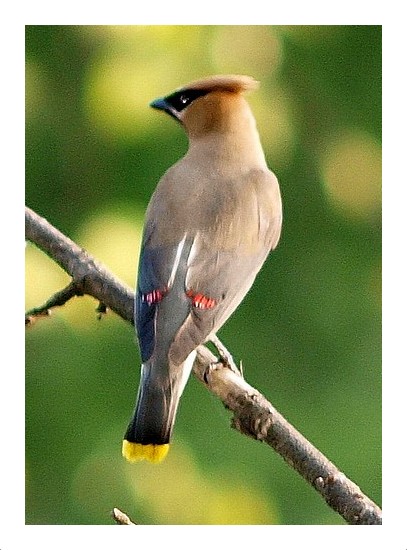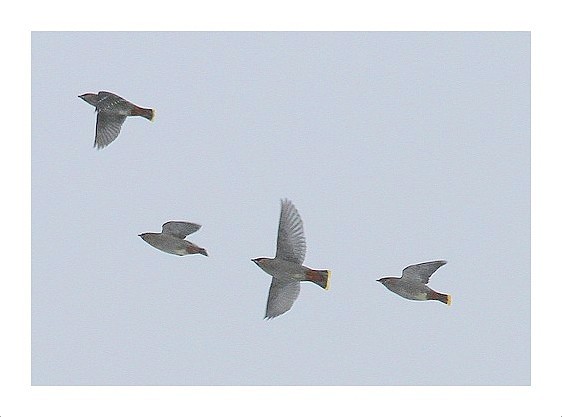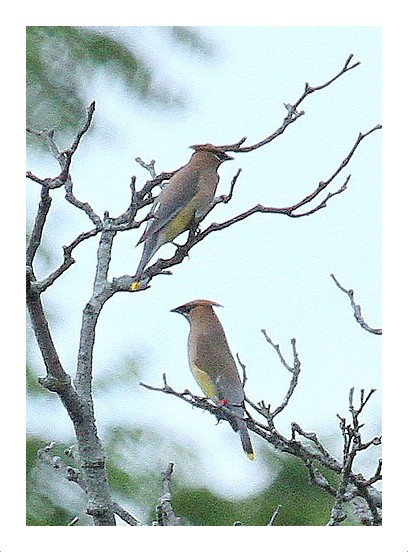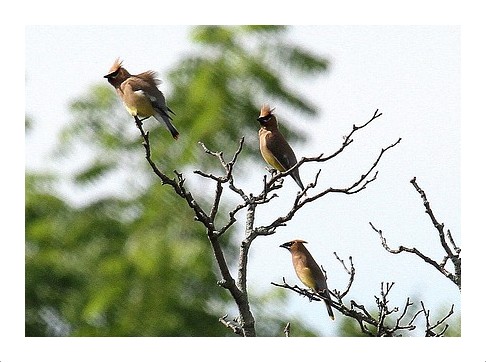Here's the Background on a Backyard Beauty
The Peregrine Vol 19, No 5 & 6, September/October & November/December 2020
Complete Article
Cedar Waxwing

Here's the Background on a Backyard Beauty
It's been a good year for observing birds out my back windows. First there were four Baltimore Orioles that I wrote about in May/June 2020 edition of The Peregrine - birds that we never had at our feeders before. Now in June a pair of Cedar Waxwings appeared in a tree on the next street over - birds we had not seen in the yard since 2006! And this pair stayed and have been nesting in a tree on that next street.
I first saw a single waxwing on its perch on June 15, a nice surprise after a 14 year lapse. The perch was in several dead limbs at the top of a Norway maple, a good spot to view 360o in the area. It is typical for a male Cedar Waxwing to have a guarding perch within eyesight of his nest. Seeing the bird again on some other days was nice too, but the best sighting came a week after the first sighting. On June 22, Nancy and I witnessed two Cedar Waxwings in the tree, and one was "mate-feeding" the other. This is part of the pair bonding of waxwings, and this showed they were building a nest nearby. The mate-feeding we witnessed was accompanied by the female doing some "wing-rowing movements," representative of their stylized courtship behaviors.
Cedar Waxwings (Bombycilla cedrorum) are one of three species in the Bombycilla family; the other two are Bohemian Waxwings (B. garrulus) and Japanese Waxwings (B. japonica). All three species appear similar, but the Japanese Waxwing has a red band on its tail and other pink highlights, whereas the Cedar and Bohemian Waxwings' tail bands are yellow. All three are gregarious traveling in flocks to feed and migrate. All three are frugivorous (fruit eating) and flycatch some insects, build cup-shaped nests, produce only high-pitched sounds and trills, and sport a crest on their heads.

Waxwings are so named for to the globules of red carotenoid (astaxanthin) deposits on the tips of their secondaries. These may look waxy, thus the name, but they are hard, more like a plastic. (The Japanese Waxwing lacks these carotenoid tips.) The red of these globules and the yellow of the tail margins come from carotenoids in the bird's fruit diet. With the human introduction of alien honeysuckle into landscapes, red carotenoids (rhodoxanthin) from honeysuckle berries fed to waxwing nestlings as their tail feathers grow mixes with the normal yellow carotenoids (e,e-carotene-3,3'-dione) to produce an orange tail band. Work at Powdermill Nature Reserve under Bob Mulvihill, Bob Leberman, and others (see References) has shown that almost all waxwings with this orange tail band are immature having developed their tail feathers as nestlings at the time of year when alien honeysuckle berries with their red carotenoids were ripe and collected by their parents. Adults that may have lost tail feathers when honeysuckle berries were ripe also grew orange tipped replacement feathers due to the rhodoxanthin. During the usual waxwing molt in late summer/early fall when honeysuckle berries are no longer available, yellow-tipped tail feathers develop normally thanks to the absence of the red carotenoid rhodoxanthin.
Cedar Waxwings get their 'first' name from the Eastern Redcedar, a common juniper tree, the fruits of which are favorites of the bird. Other fruits and berries in their diet include cherry, chokecherry, viburnum, pokeweed, grapes, and wild strawberries, among others. They will also hawk for insects. In the spring, the waxwings will eat the flowers of fruiting trees and bushes. Getting them to eat from a backyard feeder is very difficult. They may be attracted to raisins, currents, or chopped apples if you're lucky.

of Cedar Waxwings
Cedar Waxwing flocks may migrate to the southern United States in winter or even into Mexico and Central America. In a milder winter they may not migrate far at all. Waxwings pair off within the larger flocks. They initiate their bond early in the year with a formalized "side-hop display." The male will approach a female on a branch with a berry (perhaps a flower petal or an insect) in his beak and hop sideways toward her. The female will take the berry and hop away sideways along the branch, then hop back and pass the berry back. This interaction may go on repeatedly until one of the birds eats the berry. Sometimes such an advance with a berry may be rejected by the female, so the male must move on to another more willing partner.
The Cedar Waxwing is usually a very social bird traveling in flocks much of the year. Soon after leaving their parents, fledgling waxwings form flocks of juveniles in late summer/early fall. As the parents conclude their nesting season, the adults and the juveniles may wing together in larger flocks - not family groups. The nesting season is the only time pairs break away from the flocks, but only to establish a small nesting territory, usually picked by both members with the female having more say. Yet, during the days before egg-laying occurs, the pair may join a larger flock to eat at certain spots with no conflicts between members of the larger group. Only in the nesting territory do the waxwings display aggression toward other waxwings who venture too close. Often it is the male who is most aggressive, but the female will also defend the nest. They vary their territorial instincts and their social interactions depending on the proximity to their nest.

On June 29 near 5:00 pm, three adult Cedar Waxwings sat together in the 'perch' tree. The two extra visitors may have been part of a foraging group in the afternoon stopping to rest and do some grooming. Those two left about 5:00 pm, and the resident male stayed around for another eight minutes, finally flying down in his usual way. It was surprising the two extras were tolerated in the nesting area, but the perch is usually away from the actual nest.
The waxwing's nest is located at the vee of a horizontal branch of a tree, usually high up, but 6 to 20 feet is average. Maples and cedars are often picked to nest in, while flowering fruit trees like pear, plum and hackberry are also used. The female does most of the constructing with the male bringing building material to add, twigs, grass, stems. They may steal items from the nests of other birds. She lines the nest with rootlets, fine grass, pine needles, cobwebs, even wool. Once the nest is built, a waxwing will approach it stealthily, working up from the bottom of the tree. However, the bird will depart straight out of the tree.
Egg-laying begins right after the nest is finished; the female will lay one egg each morning to an average of four or five. The oval eggs are a pale blue with speckles of dark gray or black. The female will not start full-time incubation until the third egg arrives, and only she will incubate the eggs. Therefore, the male must feed her with regurgitated fruit either on the nest or on a perch nearby. When she is off the nest, he will stand on or near the nest to guard it. This constant attention makes cowbird parasitism a seldom thing. Incubation will last from 12 to 14 days.
Loren Putnam (see References) noted that on hot days with temperatures in the 90s, the waxwings' activities slowed down. I saw this too on July 3, 4 and 5 (a hot stretch), when no observations of the birds were made on the perch tree. I also thought that after a constant barrage of neighborhood fireworks, the waxwings would disappear. Being true urban birds and with an investment in a nest, the male was seen back on his perch on July 6 and almost every day thereafter until July 16, with many of those days being into the 90s.
The newly hatched waxwings are altricial, with eyes closed, and naked. They hatch in the order they were laid. The nestlings are pink, but their skin turns dark during their first day. Both parents will feed the young chicks - at first with mashed insects but by the third day with more fruit than insects. The nestlings remain in the nest for 16 to 18 days. Feather shafts appear in the main feather tracts in five days; their eyes open in about a week; feathers break out of their shafts from 8 to 14 days after hatching. The parents both keep the nest tidy by eating the fecal sacs of the young for about ten days. By then the nestlings can defecate over the side of the nest.
The female Cedar Waxwing will brood the hatchlings during their first five days and then begin helping the male with their feeding. With the first clutch, however, the female's attention to the young begins to wane about the tenth day after hatching as she starts internal development for a second clutch. The male must take up the slack in caring for their offspring. Plus, he has to begin courting his mate again for her second brood and begin gathering material for a second nest, all the time keeping watch on their nesting territory. The waxwing pair is very busy tending to their first clutch, courting each other, building another nest, and maintaining their nest territory.
The first clutch of nestlings will leave the nest after about two and half weeks, but the parents (mostly the male) will still feed them for another ten days. The fledglings are mostly gray with a streaked breast, a small black mask, and lots of white on their faces. They do have the yellow margin on their tails and a small crest. They should be good flyers after six days. When self-sufficient, the fledglings will fly off to join the juvenile flocks to feed together. Can one imagine the phenomenal growth of these young birds from naked, blind, pink hatchlings to self-sufficient, flying, social juveniles in less than thirty days!
The waxwings' second nest cycle seems to be on a quicker pace. Usually there are fewer eggs, yet the young develop at the same rate. The secret to getting two broods into each season is the overlapping of the nest cycles with the second clutch beginning well before the first clutch is done maturing. The tremendous effort of male Cedar Waxwing is a definite factor in achieving the two nest cycles, as is the tight bond between the male and female.
How successful is the Cedar Waxwing's practice of producing two broods per season? Without interference (predation, a devasting storm, the loss of a mate, etc.) pretty good! The devotion of the parents to the nest by rarely leaving it unattended, the impressive work of the male during the transition from one clutch to the next, and the lasting, close bond between the male and female Cedar Waxwings throughout are factors which result in a 70% success rate of fledged young, far better than many other bird species.
We did not observe our waxwings after July 16. Perhaps, we thought, the pair had relocated for their second clutch, yet we had seen no young from the first in the area. Perhaps some predator had wreaked havoc on the nest. (Crows had been destructively active in the neighborhood.) The past month had been extremely dry and hot with temperatures in the 90s, not good for the lawns nor berry-producing trees. Given the waxwings' anathema for heat, perhaps the weather and lack of water had been factors in their disappearance. It was disappointing not to see a familiar bird with its distinctive crest sitting erect on top of the maple tree.
Surprise! Three weeks to the day later, Thursday, July 16 to Thursday, August 6, the Cedar Waxwing reappeared in his perch tree. He visited two more times that day, and again on August 9 and August 14. Where had he been?
As I explained above - he was probably quite busy feeding and taking care of the fledglings from his first brood, courting his mate for a second brood, and gathering new material for a second nest. It was not really late for a waxwing to begin a second brood in late July; however, other forces may have been against that happening. The lack of rain and hot days were two issues working against berry trees and bushes producing enough food for a growing bird family. The first clutch of waxwing babies may have just made it to fledging from the nest. Perhaps not. Even in August we never saw any fledglings in the area. I had gone over to the street to look for the nest but never did find it.
Unfortunately, August 14 was the last time we saw a Cedar Waxwing in the maple tree out our window. It has been an unusual breeding season with two firsts for our yard - Baltimore Orioles in the spring and Cedar Waxwings in the summer. We can be grateful we were stuck at home to be able to watch these beautiful birds visit our neighborhood.
References:
Arthur A. Allen. "Cedar Waxwing." The Book of Birds; The First Work Presenting in Full Color All the Major Species of the United States and Canada, Volume II. Gilbert Grosvenor and Alexander Wetmore, editors. Washington, D.C.: National Geographic Society, 1939. Page 220.
Paul J. Baicich and Colin J. O. Harrison. "Cedar Waxwing (Bombycilla cedrorum)." Nests, Eggs and Nestlings of North American Birds (Princeton Field Guides). Princeton: Princeton University Press, 1997. Page 264.
Nicole Bouglouan. "Japanese Waxwing; Bombycilla japonica." Oiseaux-Birds. 2020. https://tinyurl.com/y2xffre7. Accessed 28 July 2020.
John V. Dennis. "Waxwings." A Complete Guide to Bird Feeding. New York: Alfred A. Knopf, 1994. Pages 222-223.
Kim R. Eckert. "Cedar Waxwing." The Audubon Society Master Guide to Birding; Old World Warblers to Sparrows, Volume 3. John Farrand, Jr., editor. New York: Alfred A. Knopf, 1983. Pages 84-85.
Hal H. Harrison. "Cedar Waxwing, Bombycilla cedrorum." A Field Guide to the Birds' Nests; United States east of the Mississippi River. Boston: Houghton Mifflin Company, 1975. Page 166.
Marshall Iliff. "Waxwings." Identify Yourself; The 50 Most Common Birding Identification Challenges. Bill Thompson III and the Editors of Bird Watcher's Digest. Boston: Houghton Mifflin Company, 2005. Pages 272-278.
Robert S. Mulvihill, Kenneth C. Parkes, Robert C. Leberman, and D. Scott Wood. "Evidence Supporting a Dietary Basis for Orange-Tipped Rectrices in the Cedar Waxwing." Journal of Field Ornithology. Vol. 63, No. 2, Spring 1992. National Aviary, https://tinyurl.com/y5crx2fj. Accessed 31 July 2020.
Erkki Pullianen. "Waxwing." A Dictionary of Birds. Bruce Campbell and Elizabeth Lack, editors. Vermillion, SD: Buteo Books, 1985. Page 646.
Loren S. Putnam. "The Life History of the Cedar Waxwing." The Wilson Bulletin, Vol. 61, No. 3, 1949, pp. 141-182. JSTOR, https://tinyurl.com/y5mpbtd7. Accessed 28 June 2020.
Donald and Lillian Stokes. "Cedar Waxwing / Bombycilla cedrorum." A Guide to Bird Behavior; Volume II (Stokes Nature Guides). Boston: Little, Brown and Company, 1983. Pages 176-187.
John K. Terres. "Waxwing Family." The Audubon Society Encyclopedia of North American Birds. New York: Wing Books, 1980. Pages 1005-1007.
Mark Witmer. "Waxwings." National Audubon Society: The Sibley Guide to Bird Life and Behavior. Chris Elphick, John B. Dunning, Jr., and David Allen Sibley, editors. New York: Alfred A. Knopf, 2001. Pages 485-487.





